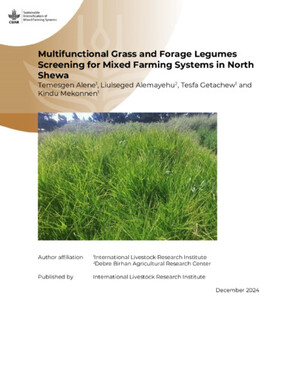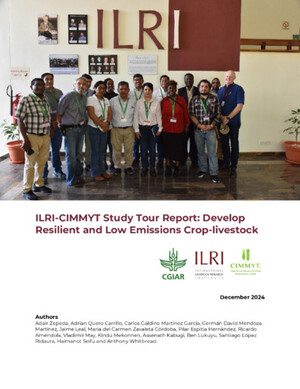
In vitro and in situ evaluation of selected multipurpose trees, wheat bran and Lablab purpureus as potential feed supplements to tef (Eragrostis tef) straw
Abstract
In vitro and in situ evaluations of feed samples were carried out at Debre Zeit Research Station (Ethiopia) of the International Livestock Research Institute. The feed samples consisted of tef straw, wheat bran, dried Lablab purpureus, and dried foliage of the multipurpose trees (MPT), namely Sesbania sesban 1198, Sesbania sesban 15019, Acacia angustissima 15132, Leucaena pallida 14203, and mixtures of S. sesban 1198+L. pallida 14203; S. sesban 15019+L. pallida 14203; S. sesban 1198+A. angustissima 15132; S. sesban 15019+L. pallida 14203 at a ratio of 2:1. The objectives of the study were to assess the nutritive value of the feed samples and to also consider their potential as supplements to tef straw. The MPTs contained higher crude protein (CP) (216–278 g kg-1 dry matter (DM)), and lower neutral detergent fiber (NDF) (204–338 g kg-1 DM) than wheat bran and L. purpureus. Anti-nutritive factors such as soluble phenolics and fiber bound condensed tannins were high in A. angustissima 15132 and L. pallida 14203, respectively. Wheat bran produced significantly more gas (P<0.001) than either sole or mixtures of MPTs, but the rate of gas production was significantly greater (P<0.001) for the MPTs than for wheat bran. Significantly lower (P<0.05) extent and rate of gas production were observed in sole A. angustissima 15132 than in its mixtures with both accessions of S. sesban. L. pallida 14203 yielded significantly lower (P<0.05) in vitro ammonia than its mixtures with both accessions of S. sesban. Sole L. pallida 14203 and A. angustissima 15132 had significantly lower (P<0.05) in vitro dry matter digestibility (IVDMD), in situ potential and effective degradability of DM and nitrogen (N) than their respective mixtures with both accessions of S. sesban. Acid detergent fiber (ADF) and NDF had a strong negative impact on the rapidly degradable and potential degradability of DM (P<0.001), whereas neutral detergent fiber bound N (NDF-N) significantly limited (P<0.05) the rate and effective degradability of DM, as well as the extent and rate of in vitro gas production. IVDMD was also negatively influenced by contents of NDF (P<0.01), ADF and acid detergent lignin (ADL) (P<0.05). In situ extent of DM degradability, potential and effective degradability of DM were positively correlated (P<0.01) with IVDMD, and the rate of in vitro gas production was also positively correlated (P<0.05) with the rate of in situ DM degradability. It is concluded that all the MPTs and their mixtures have desirable characteristics as potential feed supplements to tef straw compared with wheat bran or L. purpureus. Within the MPTs, A. angustissima 15132 and L. pallida 14203 could be inferior supplements to tef straw compared to S. sesban 1198 or S. sesban 15019. However, mixing both accessions of S. Sesban with either A. angustissima 15132 or L. pallida 14203 has the potential of improving the utilization of the latter MPTs. Moreover, it is concluded that in vitro gas production, in situ DM degradation and IVDMD methods could be alternatively used to evaluate the nutritive value of feeds similar to those used in this study.
Citation
Animal Feed Science and Technology;108(1-4): 159-179










